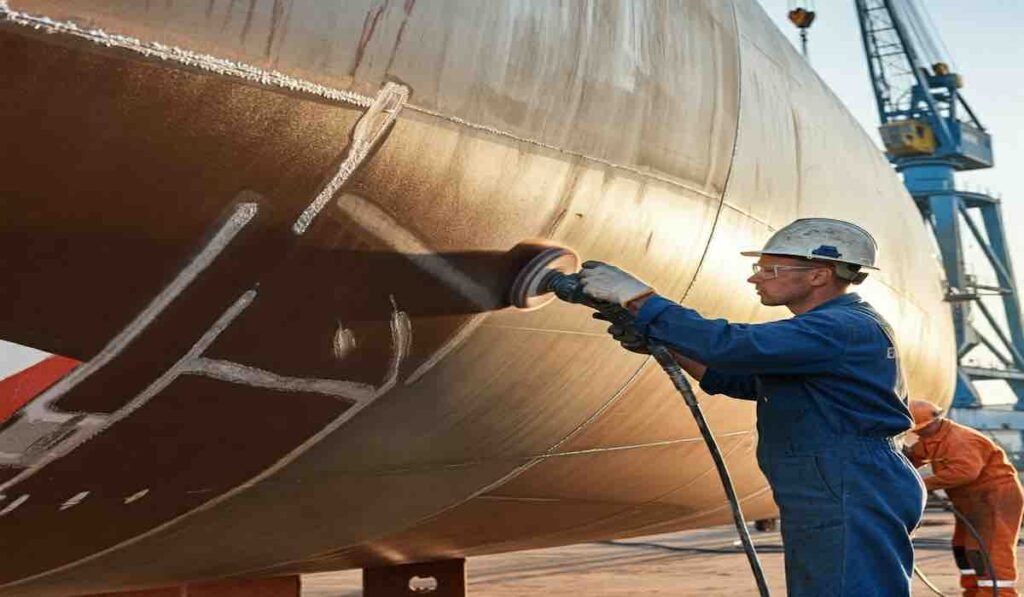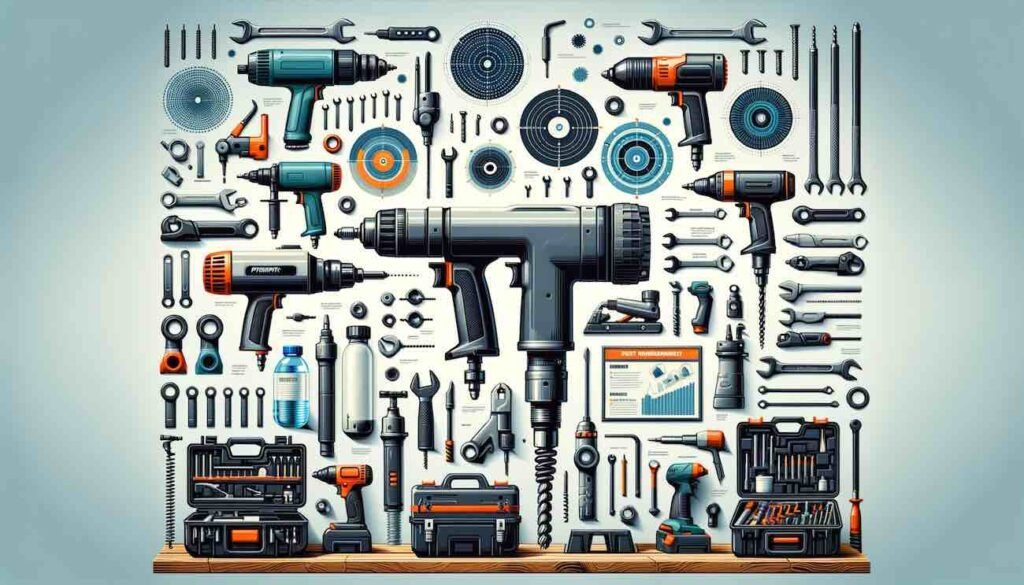When we think of pneumatic tools, our minds often jump to construction sites, auto repair shops, or manufacturing plants. However, the versatility and efficiency of air-powered tools have led to their adoption in a wide range of unexpected industries. From delicate artistic work to heavy-duty industrial applications, pneumatic tools have found their place in sectors that might surprise you. In this article, we’ll explore ten industries that rely heavily on pneumatic tools, showcasing the adaptability and indispensability of this technology.
Key Takeaways
- Pneumatic tools have applications far beyond traditional construction and manufacturing settings.
- The precision, power, and versatility of air-powered tools make them valuable in industries ranging from food processing to aerospace.
- Many industries rely on pneumatic tools for their ability to operate in challenging environments, provide consistent results, and improve efficiency.
- The adoption of pneumatic tools in various sectors often leads to increased productivity, improved product quality, and enhanced worker safety.
- Understanding the diverse applications of pneumatic tools can inspire innovation and cross-industry adoption of these versatile instruments.
1. Food Processing and Packaging
The food industry might not be the first thing that comes to mind when thinking about pneumatic tools, but they play a crucial role in modern food processing and packaging operations.
Applications:
- Pneumatic cutting tools for precise portioning of meats and other food products
- Air-powered conveyor systems for moving food items through processing lines
- Pneumatic filling and sealing machines for packaging foods and beverages
- Air-driven mixers and blenders for large-scale food production
Benefits:
- Improved hygiene due to the absence of electrical components in food contact areas
- Consistent and precise operations, crucial for maintaining food quality and safety standards
- Easy cleaning and maintenance, essential in food processing environments
2. Textile Manufacturing
The textile industry has embraced pneumatic technology to enhance various aspects of fabric production and processing.
Applications:
- Pneumatic looms for weaving fabrics at high speeds
- Air-jet spinning systems for yarn production
- Pneumatic fabric cutting tools for precise and efficient cutting of textiles
- Air-powered sewing machines for industrial-scale garment production
Benefits:
- Increased production speeds compared to mechanical systems
- Reduced wear and tear on machinery components
- Improved precision in cutting and sewing operations
3. Jewelry Making
The delicate art of jewelry making has found an unlikely ally in pneumatic tools, which offer both power and precision.
Applications:
- Pneumatic engraving tools for intricate detailing on metal surfaces
- Air-powered polishing and buffing tools for achieving high-gloss finishes
- Pneumatic setting tools for securing gemstones in place
- Air-driven casting machines for creating jewelry molds
Benefits:
- Fine control for detailed work on precious metals and stones
- Reduced hand fatigue for artisans during repetitive tasks
- Consistent results in finishing and polishing operations
4. Aerospace Industry
While it’s well-known that the aerospace industry uses advanced technologies, the extent to which it relies on pneumatic tools might be surprising.
Applications:
- Pneumatic drilling and riveting tools for aircraft assembly
- Air-powered sanders and polishers for surface preparation and finishing
- Pneumatic torque wrenches for precise tightening of critical components
- Air-driven paint sprayers for applying specialized coatings
Benefits:
- High power-to-weight ratio, crucial for reducing worker fatigue in assembly operations
- Precision control for meeting strict aerospace manufacturing tolerances
- Ability to operate in environments where electrical tools might pose safety risks
5. Medical Device Manufacturing
The production of medical devices requires extreme precision and cleanliness, making pneumatic tools an ideal choice.
Applications:
- Air-powered micro-drilling tools for creating precise holes in medical implants
- Pneumatic assembly tools for putting together complex medical devices
- Air-driven polishing and deburring tools for finishing medical-grade components
- Pneumatic dispensing systems for applying medical-grade adhesives and coatings
Benefits:
- Ability to maintain sterile conditions due to the absence of electrical components
- Precise control for manufacturing components with extremely tight tolerances
- Consistent performance crucial for producing reliable medical devices
6. Woodworking and Furniture Making
While traditional woodworking often brings to mind hand tools, modern woodworking and furniture manufacturing rely heavily on pneumatic technology.
Applications:
- Pneumatic nail guns and staplers for fast and efficient assembly
- Air-powered sanders for smooth surface preparation
- Pneumatic spray guns for applying finishes and paints
- Air-driven routers and carving tools for intricate woodwork
Benefits:
- Increased speed and efficiency in assembly and finishing processes
- Reduced physical strain on workers during repetitive tasks
- Consistent results in nailing, stapling, and surface finishing
7. Glass Manufacturing and Processing
The glass industry utilizes pneumatic tools in various stages of production and processing.
Applications:
- Pneumatic glass cutting tools for precise scoring and breaking
- Air-powered polishing and grinding tools for edge finishing
- Pneumatic suction cups for safely handling large glass sheets
- Air-driven spray systems for applying protective coatings
Benefits:
- Precise control for working with fragile glass materials
- Reduced risk of contamination in clean room environments
- Ability to handle large and heavy glass pieces with ease
8. Leather Working and Shoe Manufacturing
The leather industry, including shoe manufacturing, has found numerous applications for pneumatic tools.
Applications:
- Pneumatic leather cutting tools for precise and efficient cutting
- Air-powered sewing machines for heavy-duty stitching
- Pneumatic presses for applying adhesives and forming shoe components
- Air-driven nail guns for attaching soles to shoes
Benefits:
- Consistent pressure application crucial for high-quality leather goods
- Increased production speeds in shoe assembly lines
- Ability to work with a wide range of leather thicknesses and textures
9. Marine Industry
Shipbuilding and marine maintenance operations rely heavily on pneumatic tools due to their durability and performance in challenging environments.
Applications:
- Pneumatic hull cleaning and scaling tools
- Air-powered drilling and fastening tools for ship construction and repair
- Pneumatic paint removal and application systems
- Air-driven pumps for bilge and tank cleaning operations
Benefits:
- Ability to operate in wet and corrosive environments
- High power output for demanding marine applications
- Safety advantages in potentially explosive atmospheres on ships and oil rigs
10. Theme Park and Amusement Ride Manufacturing
The entertainment industry, particularly in the realm of theme parks and amusement rides, makes extensive use of pneumatic technology.
Applications:
- Pneumatic actuators for animatronic figures and special effects
- Air-powered control systems for ride operations
- Pneumatic braking systems for roller coasters and other rides
- Air-driven tools for ride assembly and maintenance
Benefits:
- Reliable and precise control for safety-critical ride operations
- Ability to create smooth and realistic movements in animatronics
- Durable performance in outdoor entertainment environments
Added Information
- In the food processing industry, pneumatic cutting tools can achieve cutting speeds of up to 500 cuts per minute, significantly outpacing manual methods.
- Pneumatic looms in textile manufacturing can produce up to 2,000 meters of fabric per day, a substantial increase over traditional mechanical looms.
- In aerospace manufacturing, pneumatic riveting tools can set up to 400 rivets per hour, crucial for efficient aircraft assembly.
- The global market for pneumatic tools in the medical device manufacturing sector is expected to grow at a CAGR of 6.8% from 2021 to 2028, reflecting the increasing reliance on these tools in this precision-driven industry.
- In the marine industry, pneumatic tools are designed to operate in saltwater environments and can withstand pressures up to 5,000 PSI, making them ideal for underwater applications.
Frequently Asked Questions
Why are pneumatic tools preferred in food processing over electric tools?
Pneumatic tools are preferred in food processing because they don’t have electrical components that could pose contamination risks. They’re easier to clean, can operate in wet environments, and don’t generate heat that could affect food quality.
How do pneumatic tools contribute to worker safety in these industries?
Pneumatic tools often reduce workers’ physical strain, lowering the risk of repetitive strain injuries. They also eliminate the risk of electric shock in wet environments and can be designed with safety features like automatic shut-offs.
Are pneumatic tools more cost-effective than their electric counterparts in these industries?
While the initial investment in a pneumatic system can be higher due to the need for an air compressor, pneumatic tools often have lower maintenance costs and longer lifespans. In high-volume production environments, this can lead to significant long-term cost savings.
How are pneumatic tools adapted for use in clean room environments like medical device manufacturing?
Pneumatic tools for cleanroom use are often made from materials that don’t generate particles. They’re designed to be easily sanitized and may include special filters to ensure that the exhaust air doesn’t contaminate the environment.
Can pneumatic tools be used in explosive environments?
Yes, pneumatic tools are often preferred in potentially explosive environments because they don’t produce sparks like electric tools can. This makes them safer in industries like shipbuilding or oil and gas, where flammable materials may be present.



